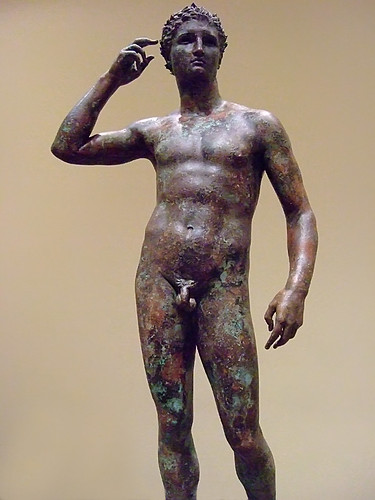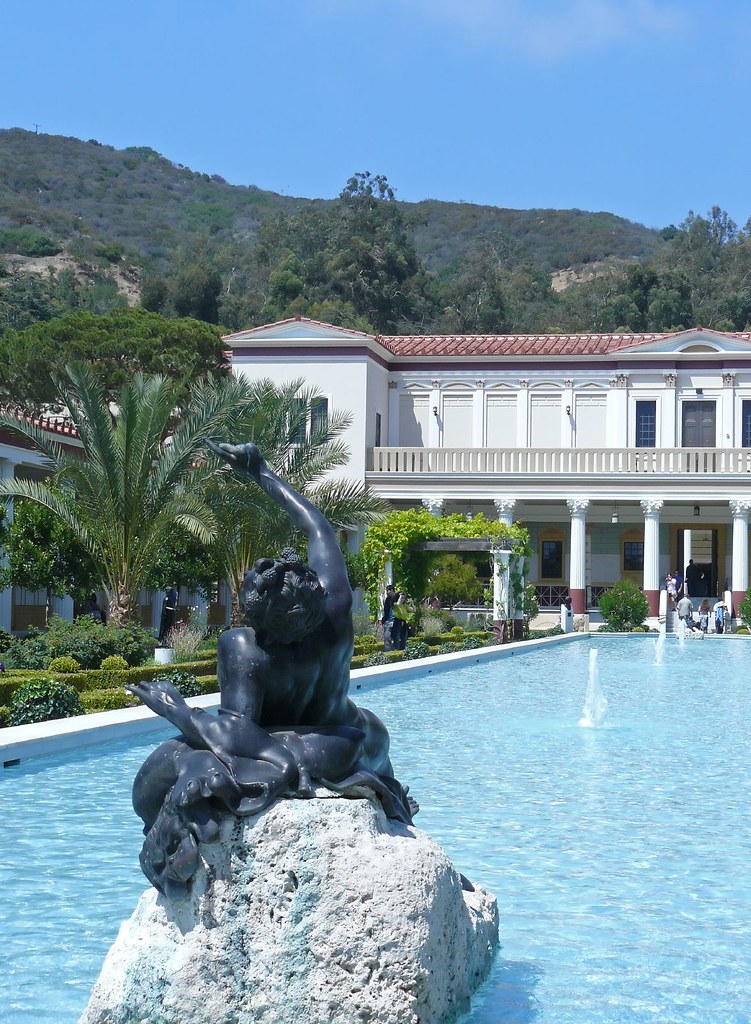Once more, the J. Paul Getty collection of antiquities may be depleted due to the repatriation of a 4th century BC bronze called ‘Statue of a Victorious Youth‘ thought to be the work of Lysippos, a Greek sculptor who flourished under the patronage of Alexander the Great.
The work was originally salvaged from the depths of the Adriatic sea near the Italian town of Fano in 1964 by Italian fishermen trawling in international waters. The real irony in the Italian court’s ruling ordering the confiscation of the work from the Getty is that the bronze was probably on its way to Rome after being plundered from a city in Greece between 300 – 100 BC. If the work was truly returned to its country of cultural origin it would be going home to Greece not Italy. This is the point where arguments for and against repatriation get sticky. Just how far back in history do you go to determine the “rightful” owner?
In his essay The Repatriation of Cultural Objects, Leong Yew describes the often “long and troubled history” of artefacts from abroad that are now housed in Western museums or collections. He says:
“Most of these have now come under scrutiny by a burgeoning postcolonial consciousness that their location in these places are inherently problematic. At the same time the claims of ownership by native communities are equally unsettled as issues of the “right” of ownership, the identity of the owner, and the circumscription of global capitalism and modern property law persistently colour these claims. Hence, much like the diasporic peoples around the world, indigenous art – once displaced – becomes caught in in-between hybrid spaces, never fully belonging to the countries that host them or to the places they originated.”
Assessing Cultural Importance
Some of the most impassioned proponents of restitution try to frame their claims in terms of a particular work’s importance to a nation’s cultural heritage. In fact, Article 5(3) of the treaty hammered out by UNIDROIT (International
Institute for the Unification of Private Law) states that the return of illegally exported cultural objects should be based on factors related to preservation, context, or cultural significance of the object. It further explains that objects should be returned if it is established that the removal of the object from the country of origin significantly impairs one of the following interests: the physical preservation of the object or its context, the integrity of a complex object, the
preservation of information, the traditional or ritual use of the object, or if it is shown that the object is of significant cultural importance to the requesting state.
It is interpretation of the last issue that has proved problematic in the determination of who should ultimately become the custodian of particular ancient art objects.
“What may at one time have been a tribal religious statue may have existed in a relationship with its native possessors in a way that cannot be articulated outside of modernity and capitalism,” Yew says. “The original communities that possessed the disputed art have become transformed by colonialism and capitalism in varying ways. New sovereign states may have superceded these communities and hybrid notions of ownership – trapped between traditional and modern – may have become the very elements that propel these claims for artistic repatriation.”
You Can’t Repatriate to Greaco-Rome
In the case of the ‘Victorious Youth’, the art itself muddies the waters a bit as well. If you were to take a purist viewpoint, you would support a court ruling returning the bronze to Greece, its actual point of cultural origin if it was not, in fact, a Roman commissioned copy of a Greek original. If it is an original by Lysippos, it represents the cultural heritage of ancient Greece not ancient Italy. If it was a Roman commissioned copy but was produced by Greek sculptors then under the rule of the Roman Republic, interpretation would not be so straightforward. Obviously the
original buyer of the work, presumably Roman, is long dead and not traceable, especially since the work was a victim of a maritime mishap and not found in an identifiable archaeological context. But in a modern context, would it be appropriate to rule it representative of Roman culture during the period and therefore of significant cultural importance to Italy or use cultural origin as our guideline and award custody to Greece?
A complicating factor in this case is the transformative effect of Hellenisation on Roman civilization that occurred after the second Punic War. As Greek art, religion and literature were embraced by the Roman elite, much artwork was produced for the Roman market by Greek artisans, both in Greece and by Greeks who immigrated to the burgeoning Republic seeking their fortunes. When that artwork is removed from the context of identified ownership and viewed through the prism of our capitalistic society two millenia later, do we prioritize cultural impact when considering which country will ultimately get to cash in on the cultural tourism an object might produce? After all, despite all the high minded proclamations of preserving cultural heritage, the bottom line is that most of the art is actually viewed by the claimants as simply a revenue source.
The Law on Loot
Furthermore, what if the statue was looted from its original cultural context by the Romans and not legitimately purchased? If the torah from the temple in Jerusalem was found in the excavations of a villa once owned by Vespasian or Titus, I’m sure Israel would be clamoring for its return. How would a Greek statue plundered by a Roman general be any different?
Getty’s compliance with the Italian court order is still speculative. U.S. courts have traditionally ruled favorably for plaintiffs in cases involving restitution of cultural objects. In this case, however, the Italian court is basing ownership on the Italian law of 1939 Regarding the Protection of Objects of Artistic and Historic Interest that claims state ownership of archaeological finds and antiquities found after 1902, not any international treaty, especially since the recovery of the Victorious Youth occurred six years before even the 1970 UNESCO convention developed a treaty governing the import of archaeological and ethnological materials. Furthermore, the find was recovered in international waters, not within the territorial boundaries of Italy.
Basing repatriation on site of discovery has proven to be frought with problems in previous litigation. In the case of The Republic of Lebanon vs. Sotheby’s, a court denied all three claimants to an $80 million Roman hoard.
Lawrence M Kaye, in the essay Art Wars the Repatriation Battle, says: “Although Lebanon dropped out of the case, the introduction of expert and factual testimony by Croatia and Hungary failed to convince a jury that the treasure had been discovered in either countrys territory. As a result, neither could invoke its national ownership law as a predicate to establishing a property right to the treasure.”
Obviously, relying on proof of discovery site is particularly problematic for looted items whose archaeological context has been lost.
Ultimately, the statue will probably become just another piece to secure further agreements between the Getty and the Italian government to guarantee long term loans of significant works of art so art and history lovers of both countries may be enriched through its exhibition and study. I hope so.


